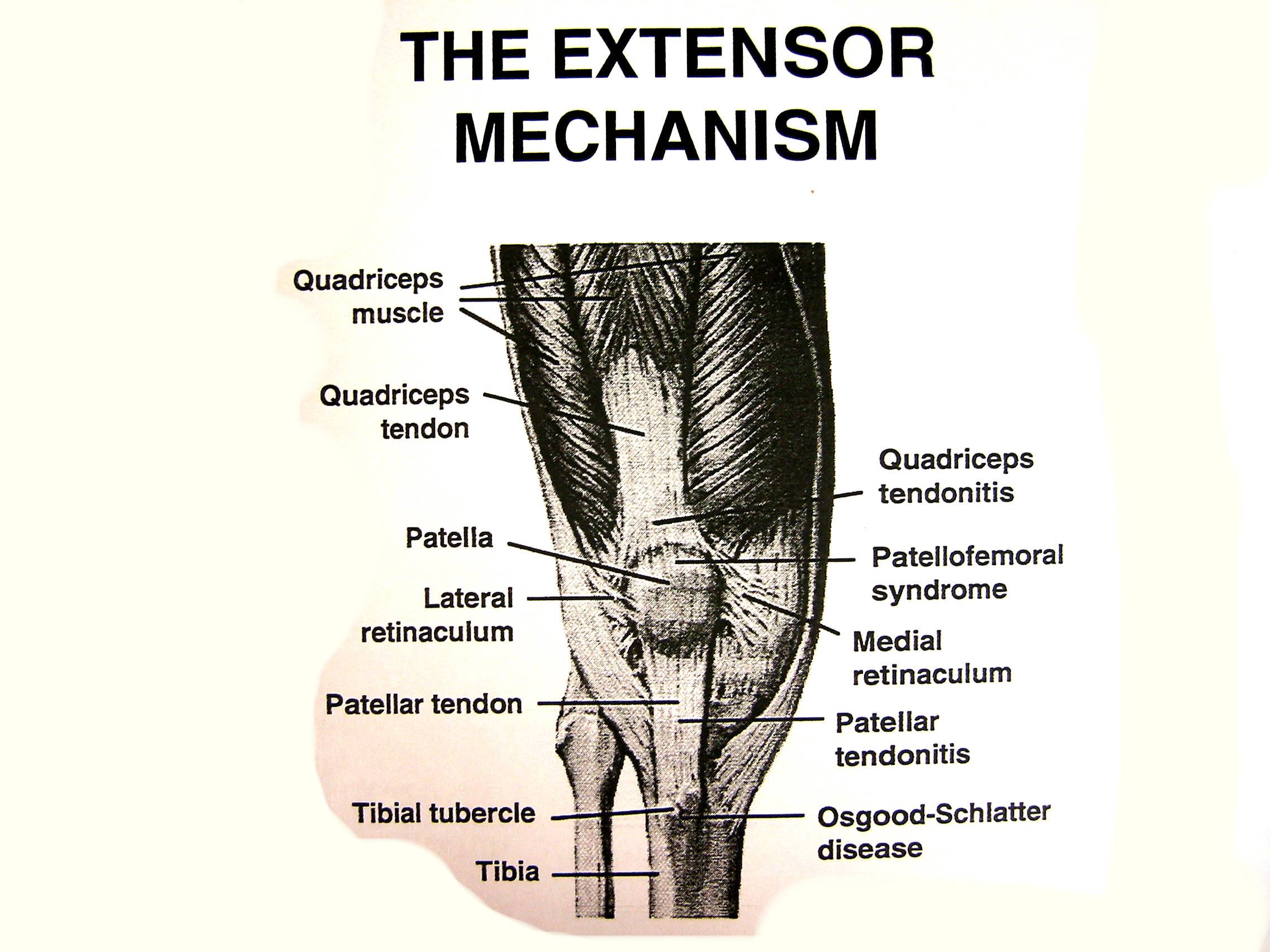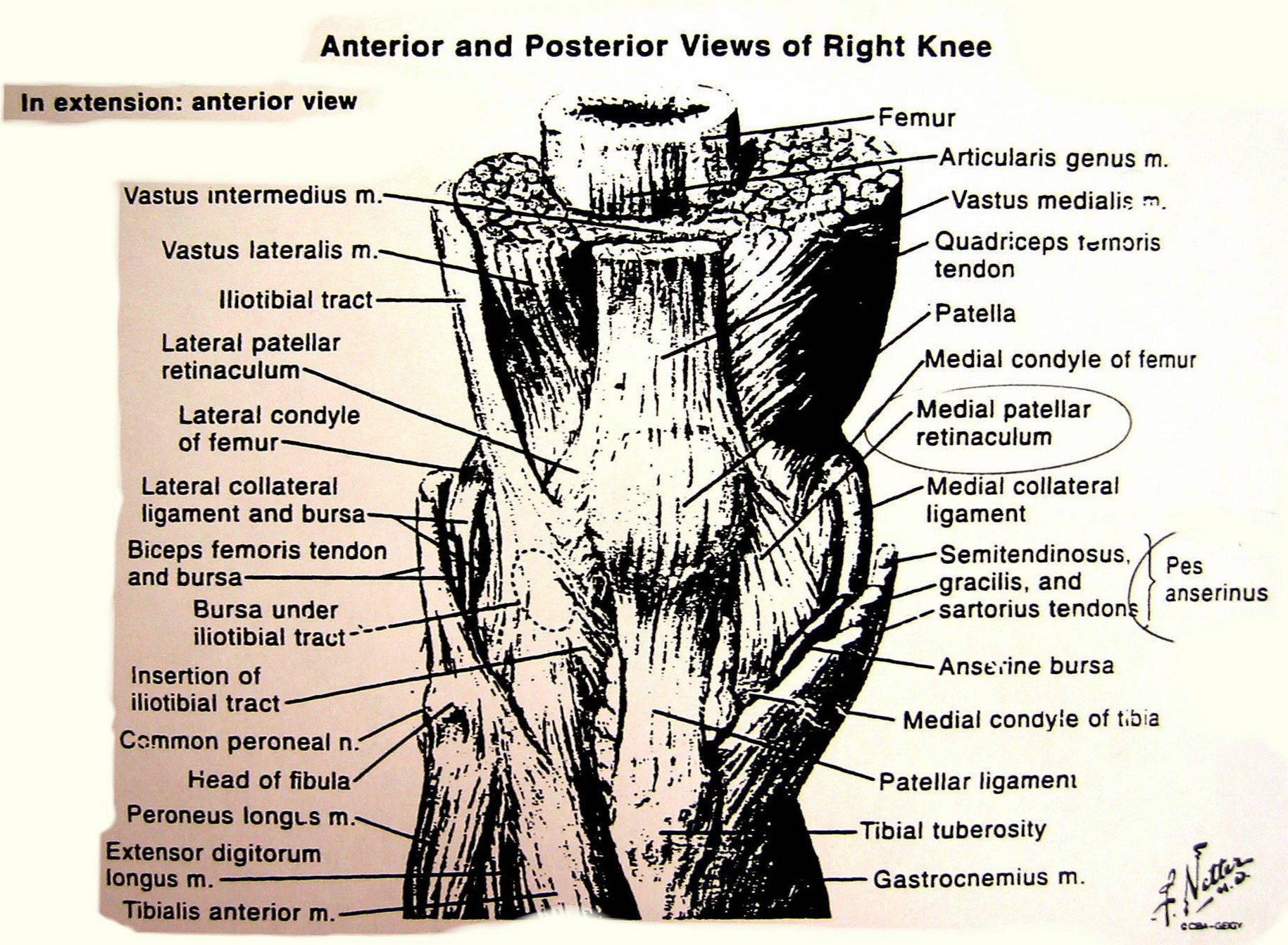 TOC |
Rheumatology
TOC |
Rheumatology

Approach to Knee Pain
REF: Painful Knee Test
2008
Strategy I.
Separate all knee pain patients into one of three categories:
-
Routine office visit knee pain
-
The hot swollen atraumatic knee -
need knee tap
Septic arthritis
Gout, pseudogout
Autoimmune-inflammatory
-
Acute knee injury: the blow
out --> See the Examination
& the Referral Decisions for acutely
injured knee below!
Strategy II.
Analyze the location
of the most painful part of knee
in all routine office visit knee pain complaints
Anterior - Medial - Lateral - Posterior Knee Areas


| Anteriorly
|
Medially
-
Meniscal tear or cyst
Symptoms of meniscal pathology: pain, swelling, locking with flexion,
giving way
Signs: medial joint line tenderness, effusion/synovitis, locked
knee, atrophy, loss of full extension or flexion
-
Osteoarthritis
History: older age, activity trauma, surgery, effusions, pain
P/E: joint line tenderness, varus, crepitation, effusion, Pain at extreme
motion
X-ray: narrowing, osteophytes, sclerosis, cysts
Rx: bicycling, PT Rx, NSAID, chondroitin & glucosamine, activity
modification, steroid injection, surgery, ? hyaluronate injection?
-
Osteochondritis dissecans (rare)
Cause unknown, may be avascular necrosis of bone or femoral condyle
Teenage boys ? girls 10:1
Pain, swelling +/- locking, effusion, atrophy, tenderness, 1 year course
Knee X-ray of Tunnel View
Refer to Ortho for persistent pain, effusion, or locking
Rx: activity modification _/- arthroscopy
-
Osteonecrosis of the femoral condyle (rare)
Older age group > 60 yo with sudden severe pain while walking
("spontaneous")
Pain unrelenting, tumor like , unresponsive to usual Osteoarthritis Rx
Initial X-ray negative, Tunnel View x-ray positive, later MRI shows avascular
necrosis (AVN)
Crutches, steroids, bike exercise, may need TKR (Total Knee Replacement)
|
Laterally
-
Meniscal tear, cyst, discoid
Meniscal Cyst (Lateral > Medial) is the mucinous degeneration in a meniscus
that produces a mass over or near lateral joint line. Never a tumor.
Ignore if possible. Aspirate if requested x1. Definitive Rx includes
a menisectomy, so treat by benign neglect if possible.
Symptoms of meniscal pathology: pain, swelling, locking with flexion,
giving way
Signs: join line tenderness, effusion/synovitis, locked knee, atrophy, loss
of full extension or flexion
-
Osteoarthritis
-
Ilio-Tibio-"Band" Fascia Friction syndrome
Usually sports related, high arches, the only cause of pain & tenderness
above lateral joint line!
Rx: stretch ITB, warm up, ice, NSAID, steroid injections last resort.
-
Biceps tendinitis
Activity related, tender tendon at posterolateral side of knee above fibular
head.
|
Posteriorly
-
Knee Effusion of any cause
Large amount of synovial fluid commonly produces tightness, fullness, or
discomfort in back of knee.
Rx the cause of effusion.
-
Baker's cyst
Usually due to the herniation of fibrosynovial knee tissue into the popliteal
fossa due to intra-articular disease. Always benign, best ignored.
Aspirate x1 only if needed to prove diagnosis.
-
Sciatica
May cause pain behind knee from radiculopathy or hamstring spasm. A
pseudo-flexion contracture may be present.
 |
Strategy III. ** Consider Timely Orthopedic
Referral for the following patients:
-
Recurrent effusion
(in otherwise "healthy"
knee)
-
Giving way
(with strong quadriceps muscle)
- torn meniscus
- loose body
- patella subluxation
- ligamentous instability
-
Locking of the knee
(not pseudo-locking)
- torn meniscus
- loose body
- osteoarthritis
- pseudolocking
-
Definite loud pop at time of
injury
- Anterior Cruciate Ligament ACL Tear
- Meniscus Tear
- Dislocated patella
- Torn MCL
Patello-femoral Pain
Syndrome

Symptoms of Patello-femoral Pain Syndrome
-
Anterior knee pain
-
Popping & clicking
-
Instability - Giving Way
-
Pseudo-locking
-
Pain after sitting (movie sign)
-
Pain ascending stairs
-
Effusion & "swelling" are not usual
-
The patellar pain are aggravated by flexed knee activities as sitting, climbing,
squatting
Physical Findings in Patello-femoral Pain Syndrome
-
Muscle contractures
-
Quadriceps atrophy
-
Q-Angle increased
-
Foot alignment (pronation)
-
Apprehension Sign (in dislocators)
-
Effusion, heat are not typical
Conservative Rx of Patello-femoral Pain Syndrome
-
Stretching
-
Strengthening
-
Orthotics
-
Soft goods
-
Activity modification
-
NSAID as analgesics
Surgical Rx of Patello-femoral Pain Syndrome
-
Soft Tissue:
-
Lateral release
-
Proximal realignment
-
Distal realignment
-
Bone Tissue:
-
Distal realignment
-
Tibial tubercle osteotomy
-
Chondroplasty
-
Patellectomy

Prepatellar Bursitis
("Housemaid's Knee") : Sterile bursitis
-
vs septic bursitis (abscess &
cellulitis) which looks awful with moderate pain.
-
Rx of septic bursitis: aspirate or I/D, culture & sensitivity, antibiotics
Rx
Patellar Tendinitis
("Jumper's Knee")
-
Pain & tenderness in tendon below patella
-
Rx: warm up, stretch, NSAID, ice, activity modification, brace.
Quadriceps
Tendinitis
-
Pain & tenderness above patella, ma lead to rupture
-
Rx: stretch, strengthen, activity modification, etc.
Pes Anserinus Bursitis/
Tendinitis
-
Pain, tenderness, & swelling below medial joint line anteriorly
-
Differential Dx: stress fracture of tibia
Plica Syndrome
-
Overly diagnosed, normal fibrosynovial fold in knee
-
Rarely a cause of knee pain except after a direct blow
Chondromalacia patella
-
It is age related & usually asymptomatic
-
It should be rejected as a clinical diagnosis
-
The identical clinical syndrome can occur when the articular cartilage has
a normal appearance (Insall 1982)
Osgood-Schlatter Disease:
-
Traction apophysitis, esp. in teenage boys.
-
Tender & swollen over tibial tubercle
-
Rx: activity modification (rest, no jumping), stretch, strengthen, ice
General Treatment of Painful Knees:

Bicycling!
-
Strengthens muscles
-
Aerobic fitness decreased chronic pain
-
Weight control
-
Mechanical smoothing
-
Stimulates some healing in cartilage
Others:
-
Stretch & strengthen
-
NSAID
-
Activity modification
-
Steroid injections
-
Softwear
The Examination of
The Acutely Injured Knee

* Must get knee x-ray for all acute injured knee to rule out fracture
or loose bodies.
The Critical Questions (History)
-
1st time or recurrent problem, has it happened before?
-
Loud "POP" at time of injury (Anterior Cruciate Ligament Tear?)
-
Timing of swelling (SLOW - effusion; FAST - hemarthrosis)
-
Can pt continue the activity/sport or not
Six Steps to Evaluating The Acutely Injured
Knee:
-
Support the painful knee with a support ("a can") to keep the flexion
about 20o
-
Check for knee effusion vs hemarthrosis
-
Check for Range of Motion assisted: Is the knee locked, cannot
extend of flex over 90o
-
Examine the Patella for stability & retinacular tenderness
- Apprehension Sign (Fairbank's Test) - move Patella laterally
- Medial patellar Retinacular tenderness
- Hemarthrosis
-
Examine the Ligaments (R/O Tear) by palpation & stress
maneuver
- MCL (Medial Collateral Ligament): palpate & stress it
- ACL (Anterior Cruciate Ligament): Lachman's test & pivot shift
- LCL (Lateral Collateral Ligament): palpate & stress it
- PCL (Posterior Cruciate Ligament): Sag sign
-
Examine the Extensor mechanism: integrity versus disruption
- active extension possible?
- palpate patellar tendon for defect (rupture)
- palpate quadriceps tendon for defect (rupture)
- compare location of right & left patellae
Initial Treatment of Sprained Knee (Except displaced
fractures)
-
Aspiration rarely needed
-
Minor: RICE (rest, ice, compression, elevation); crutches, partial
weight bearing
-
Major: large compressive bandate "Jones", splint slightly flexed, crutches,
analgesics (NSAID)
Referral Decisions
for The Acutely Injured Knee:

Immediate Orthopedic Consultation for:
-
All fractures
-
Quadriceps Tendon Tear
-
Patellar Tendon Tear
-
Dislocated unreduced Patella
-
Locked Knee
Early (within 1 week) Orthopedic Consultation
for:
-
Acute ACL/PCL (Anterior/Posterior Cruciate Ligament) Tears
-
Grade 3 MCL/LCL (Medial/Lateral Collateral Ligament) Tears
-
Acute Patellar Dislocation
Elective Orthopedic Consultation for:
-
Recurrent Patellar Dislocation
-
Chronic ACL/PCL Tears

 05072003 Most of the written material from
the Knee Workshop by Dr. Barry J. Miller 2003
05072003 Most of the written material from
the Knee Workshop by Dr. Barry J. Miller 2003


![]()
![]()
![]()
![]()
![]() 05072003 Most of the written material from
the Knee Workshop by Dr. Barry J. Miller 2003
05072003 Most of the written material from
the Knee Workshop by Dr. Barry J. Miller 2003